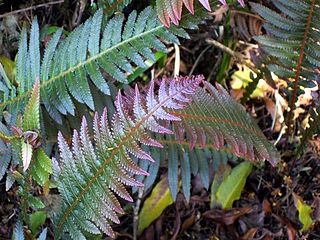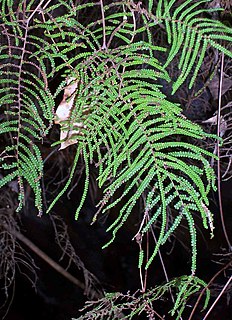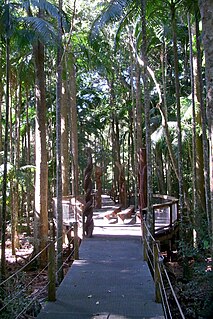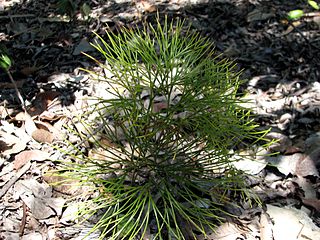
This article relates to the flora of New Zealand, especially indigenous strains. New Zealand's geographical isolation has meant the country has developed a unique variety of native flora. However, human migration has led to the importation of many other plants as well as widespread damage to the indigenous flora, especially after the advent of European colonisation, due to the combined efforts of farmers and specialised societies dedicated to importing European plants & animals.

Pteris vittata, commonly known variously as the Chinese brake, Chinese ladder brake, or simply ladder brake, is a fern species in the Pteridoideae subfamily of the Pteridaceae. It is indigenous to Asia, southern Europe, tropical Africa and Australia. The type specimen was collected in China by Pehr Osbeck.

Woodsia alpina, commonly known as alpine woodsia, is a fern found in northern latitudes in North America and Eurasia. Also known as northern woodsia or alpine cliff fern, it is typically found in crevices, scree slopes and cliffs containing slate and calcareous rocks, especially limestone.

Vandenboschia speciosa, synonym Trichomanes speciosum, commonly known as the Killarney fern, is a species of fern found widely in Western Europe. It is most abundant in Ireland, the United Kingdom, Brittany, Galicia, Canary Islands, Madeira and the Azores, but is also found in other locations including France, Spain, Portugal and Italy. It is a relict endemic European species with a disjunct distribution, having had a much wider distribution before the climate changes of the Tertiary and Quaternary periods.

The flora of Australia comprises a vast assemblage of plant species estimated to over 30,000 vascular and 14,000 non-vascular plants, 250,000 species of fungi and over 3,000 lichens. The flora has strong affinities with the flora of Gondwana, and below the family level has a highly endemic angiosperm flora whose diversity was shaped by the effects of continental drift and climate change since the Cretaceous. Prominent features of the Australian flora are adaptations to aridity and fire which include scleromorphy and serotiny. These adaptations are common in species from the large and well-known families Proteaceae (Banksia), Myrtaceae, and Fabaceae.

Todea barbara is known as the king fern. Occurring in moist areas of south eastern Australia, and also indigenous to New Zealand and South Africa.

Doodia aspera, commonly known as prickly rasp fern, is a widespread and common plant, growing in eastern Australia. Often seen in rainforest margins or eucalyptus forest in Victoria, New South Wales and Queensland, it is a terrestrial fern with reddish new growth.

Acrostichum is a fern genus in the Parkerioideae subfamily of the Pteridaceae. It was one of the original pteridophyte genera delineated by Linnaeus. It was originally drawn very broadly, including all ferns that had sori apparently "acrostichoid", or distributed in a uniform mass across the back of the frond, rather than organized in discrete sori. This led Linnaeus to include such species as Asplenium platyneuron in the genus, because the specimen he received had sori so crowded that it appeared acrostichoid.

The North Coast Regional Botanic Garden in Coffs Harbour is a 20 hectare oasis in the heart of Coffs blending a mix of natural coastal forests, planted gardens, discovery walks and picnic areas. On Hardacre Street just one km from the Coffs Harbour CBD on the Mid North Coast region of New South Wales, Australia.

Pneumatopteris pennigera, commonly known as lime fern, gully fern, feather fern and piupiu, is a small fern found in south eastern Australia and New Zealand. It grows along streams, and is also seen in areas of open forest.

Gleichenia dicarpa, commonly known as pouched coral fern or tangle fern, is a small fern of the family Gleicheniaceae found in eastern Australia, New Caledonia and New Zealand. It forms tangled thickets in wet places such as swamps and riverbanks.

Gleichenia microphylla is a small fern growing in Australia and New Zealand.

Sticherus flabellatus is a small fern found in eastern Australia and in New Zealand, northwards from the north-west of the South Island. A common and attractive plant with shiny dark foliage and with slightly toothed edges on the smallest parts of the fronds. Often seen in large numbers in suitably moist gullies and by creeks.

Australia has approximately 11,500 km2 of mangroves, primarily on the northern and eastern coasts of the continent. Areas where mangroves occur include the intertidal zone of tropical, subtropical and protected temperate coastal rivers, estuaries, bays and marine shorelines. Less than 1% of Australia's total forest area is mangrove forest.

The Sea Acres National Park is a national park that is located in the Mid North Coast region of New South Wales, in eastern Australia. The 76-hectare (190-acre) park is situated near the town of Port Macquarie. The park is a popular tourist area with a 1.3-kilometre (0.81 mi) long boardwalk through a remnant of seaside rainforest. There is also an education centre and cafe. The park was initially declared as a nature reserve in 1987; and gazetted as a national park in October 2010.

Acrostichum aureum, the golden leather fern, is a large species of fern that grows in mangrove swamps and other wet locations. Other common names include swamp fern and mangrove fern.

Rhizophora mucronata is a species of mangrove found on coasts and river banks in East Africa and the Indo-Pacific region.
Asanoa hainanensis is a Gram-positive and non-motile bacterium from the genus Asanoa which has been isolated from the rhizospheric soil of the fern Acrostichum speciosum from Wenchang, China.

Schizaea dichotoma, the branched comb fern is a small plant usually found in open forest or heath, often on sandy soils. The habit is mostly upright, with up to 20 segments, twice or more times branched. Found in Australia, New Zealand, Papua New Guinea, Malesia and islands in the Pacific Ocean. A low plant, 20 to 40 cm tall. The specific epithet dichotoma is derived from Greek, meaning "twice cut", referring to the branched nature of the fronds. This plant first appeared in scientific literature in the year 1753 as Acrostichum dichotomum, published in the Species Plantarum by Carl Linnaeus.

Mickelopteris is a genus of ferns in the subfamily Cheilanthoideae of the family Pteridaceae with a single species Mickelopteris cordata. Synonyms include Parahemionitis cordata and Hemionitis cordataRoxb. ex Hook. & Grev. The species is native to south-eastern Asia, from India to Taiwan and the Philippines.



















